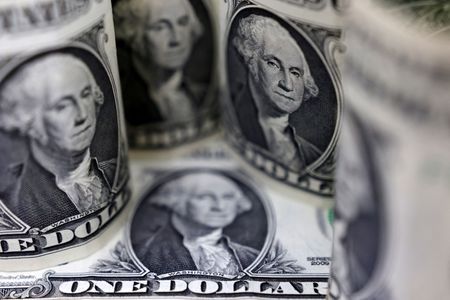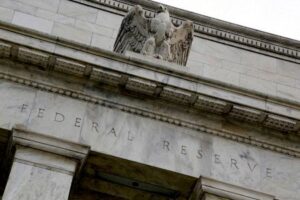By Rae Wee
SINGAPORE (Reuters) -The British pound gained a touch on Wednesday after data showed UK inflation rose slightly above expectations, while the dollar was on the defensive as traders focused on the prospect of Federal Reserve rate cuts as early as September.
British headline inflation held at 2% on an annual basis in June against forecasts for a 1.9% increase, while the closely-watched services inflation came in at 5.7%. Core inflation, however, was in line with expectations.
Sterling rose a modest 0.1% in the wake of the data, though the bounce was short-lived and it was last flat at $1.2973.
Investors had kept a close watch on Wednesday’s numbers for clues on whether the Bank of England could cut rates in August.
“This morning’s UK inflation figures will likely be of some concern to policymakers on the (Monetary Policy Committee), with continued signs of inflation remaining sticky within the UK economy,” said Michael Brown, senior research strategist at Pepperstone.
“Naturally, the figures cast doubt on the MPC delivering the first 25bp cut of the cycle at the August meeting.”
In the broader market, the dollar was mixed against its peers, failing to sustain gains after Tuesday’s U.S. retail sales data, which pointed to consumer resilience in the world’s largest economy and bolstered economic growth prospects for the second quarter.
Against the greenback, the euro firmed at $1.0900, while the Australian dollar was little changed at $0.6732.
The dollar index was flat at 104.21.
“Ultimately, the story that I think best describes it is that the markets have chosen the story of a Goldilocks economy,” said Kyle Rodda, senior financial market analyst at Capital.com.
“Yes, retail sales are solid, at least on a nominal basis, and consumer demand is strong. But the more important data is the inflation data, and that’s telling the market that the Fed is in a position to cut fairly soon.”
Investors have fully priced in a rate cut from the Fed come September, and are expecting more than 60 basis points worth of easing by the year end.
The New Zealand dollar was last 0.3% higher at $0.6068, helped by data earlier on Wednesday which showed domestically driven inflation remained high in the second quarter, even as the headline figure missed expectations.
Still, markets are sticking to bets of about three rate cuts from the Reserve Bank of New Zealand (RBNZ) this year.
“Today’s CPI release confirms that inflation is all but certain to return to the RBNZ’s 1-3% target by Q3,” said Abhijit Surya, Australia and New Zealand economist at Capital Economics.
“In the context of an extremely weak economy and a rapidly loosening labour market, there is a growing chance that the bank will start easing policy at its next meeting in August.”
The yen last rose 0.2% to 158.04 per dollar, as traders remained on alert for any intervention from Japanese authorities to prop up the currency after they had likely done so last week.
Bank of Japan data released on Tuesday suggested Tokyo may have spent 2.14 trillion yen ($13.5 billion) intervening on Friday last week. Combined with the estimated amount spent on Thursday, Japan is suspected to have bought nearly 6 trillion yen via intervention last week.
(Reporting by Rae Wee; Editing by Sam Holmes)





